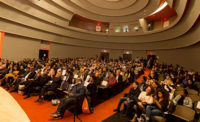Boston's young and mid-career practices find common ground in their training and research-based design.
The bold cantilever of Diller Scofidio + Renfro’s Institute of Contemporary Art thrusting over the waters of Boston Harbor revealed to locals that there could indeed be life beyond brick [RECORD, March 2007, page 108]. There is also something happening in Boston from the bottom up, an effervescence of local firms, startups that promise to sweep away some of the cobwebs that still accrue to the “Athens of America.”

Photo ' John Horner
Among the emerging generation, the firm with perhaps the highest profile is Höweler & Yoon [RECORD, November 2007, page 190; December 2007, page 82]. Eric Höweler, as it happens, worked at Diller Scofidio + Renfro between 2002 and 2005. Meejin Yoon, meanwhile, is an alumna of the Harvard Graduate School of Design (GSD). The majority of other young practices in Boston also trace a lineage to Harvard—and to Machado and Silvetti Associates, formed in 1985 and arguably Boston’s most influential firm of the last generation. Through teaching at Harvard and maintaining an active practice, Rodolfo Machado, Assoc. AIA, and Jorge Silvetti, FAIA, have influenced established young firms, including Office dA and designLAB, and more recently, Utile. It is not that one can map a stylistic coherence derived from the parent firm’s pedagogical and professional ascendancy. It is more an attitude of research and enquiry, of historical understanding and the power of analytical abstraction that explores the possibility of building in a contemporary idiom within the framework of a strong cultural heritage and a demanding physical fabric.
Harvard, MIT, and Boston’s four other architecture schools draw students from all over the world, many of whom remain in the area to pursue their careers. Thus, while the city’s architecture is often viewed as parochial, conservative, and restrained, its architects have an international diversity and sophistication constantly replenished and reoxygenated by the opportunities to teach and by the new graduates and ideas coming out of the schools. In this academic and professional symbiosis there is also a propensity for research-based design. Office dA, for instance, engages in formal and textural experimentation, reflected also in the work of younger firms, such as Merge and Studio Luz. Almost without exception, the principals of today’s young practices included on the following pages teach in area schools.
The Boston Society of Architects (BSA)—the local chapter of the AIA—and ArchitectureBoston magazine have acted as a public grandstand and salon for Boston’s mainstream architects, but a new generation of young practitioners has decided to throw its own party. Impatient with the normative tendencies of more established practices, emerging firms such as Studio Luz, Merge, and others have combined to kick over the traces of professional conformity by encouraging and exhibiting design in all its facets and embracing cultural polemic. The pinkcomma gallery and its publications, affiliated with the practice over,under, are part of this movement—as is the installation titled Young Boston at the American Institute of Architects 2008 National Convention here this month. While this is a continuation of academic culture by other means, what is remarkable—and perhaps distinctively Bostonian—is the degree of collaboration and mutual support in getting this movement going.
As interesting as the new wave is, one still has to ask why cutting-edge Boston architects are more honored in other parts of the country and overseas than perhaps they are here, at least when it comes to major buildings. Office dA has broken the mold in the private sector with the Macallen Building Condominiums in South Boston. But as far as public buildings are concerned, there is no Bostonian equivalent of New York City’s prequalification program for young, interesting firms that has opened opportunities to Boston-based Kennedy & Violich as well as Ted Galante, AIA, to design municipal buildings. Public and private investors in Boston have still for the most part been unwilling to depart from the formal stereotypes of brick and pitched roofs. So while the emerging firms’ frisky conversation on style is a welcome addition, the history of this city of revolutionary nonconformists suggests—and the future surely demands—much bolder thinking.


